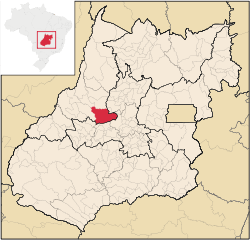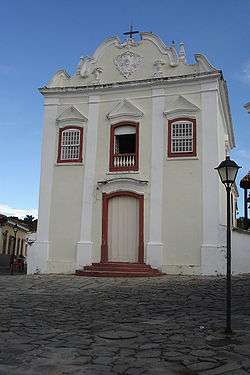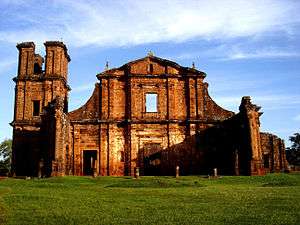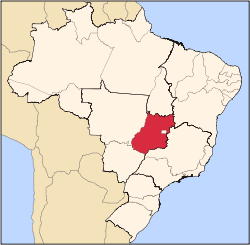Goiás, Goiás
| Goiás | |
|---|---|
| Municipality | |
 Location in Goiás state | |
 Goiás Location in Brazil | |
| Coordinates: 15°56′2″S 50°8′24″W / 15.93389°S 50.14000°WCoordinates: 15°56′2″S 50°8′24″W / 15.93389°S 50.14000°W | |
| Country |
|
| Region | Central-West Region |
| State | Goiás |
| Microregion | Rio Vermelho |
| Area | |
| • Total | 3,108 km2 (1,200 sq mi) |
| Elevation | 496 m (1,627 ft) |
| Population (2015) | |
| • Total | 24,439 |
| • Density | 7.9/km2 (20/sq mi) |
| Time zone | BRT/BRST (UTC-3/-2) |
| Website | http://www.prefeituradegoias.go.gov.br/ |
Goiás (also known as Goiás Velho, Old Goiás) is a municipality in the state of Goiás in Brazil. Its population was 24,439 (2015) and its area is 3,108 km².[1] It is the former capital of the state and preserves much of its colonial heritage. In 2002, it became a UNESCO World Heritage Site.
World Heritage Site
| Historic Centre of the Town of Goiás | |
|---|---|
| Name as inscribed on the World Heritage List | |
 | |
| Type | Cultural |
| Criteria | ii, iv |
| Reference | 993 |
| UNESCO region | Latin America and the Caribbean |
| Inscription history | |
| Inscription | 2001 (25th Session) |
It was the old state capital of Goiás until 1937, when the government seat was transferred to the recently built Goiânia. It was founded by the famed Bandeirante explorer Bartolomeu Bueno da Silva, nicknamed the Anhangüera, and was called in colonial times Vila Boa de Goyaz ("Good Village of Goyaz" in archaic Portuguese). Given its historical importance, the historical center of Goiás was included on UNESCO's World Heritage list in 2001.
Location
Municipal boundaries:
- North: Faina
- South: Mossâmedes
- East: Itaberaí
- West: Itapirapuã and Matrinchã
- Districts: Calcilândia, Buenolândia, Davidópolis, São João e Uvá. *Povoado (village): São João da Lajinha.
- Aglomerados (smaller than a village): Areias and Ferreiro
Distances
- Goiânia : 148 km
- Aruanã : 178 km
- Brasília : 307 km
Access can be made by highways GO-070 / Goianira / Inhumas / Itaberaí / BR-070.Sepin
Geography
The topography of the municipality is characterized by rugged terrain and several rivers. The Serra Dourada Mountains are nearby. Waterfalls and rapids are easily accessible from the center and several of them have beaches open to the public. The most important are:
- Balneário Cachoeira Grande, 6 km from the city
- Balneário Santo Antônio, 6 km from the city
- Balneário Bacalhau, at the entrance to the city
Rivers that cross the municipality are:
- Rio Vermelho, Urú, do Peixe, Ferreira and Índio
Political data
- Eligible voters: 20,670 (12/2007)
- Mayor: Márcio Ramos Caiado (January 2009)
- Vice-mayor: Joaquim Berquó Neto
- Councilmembers: 09
Demographic data
- Population growth rate 2000/2007: -1.46%
- Population in 1980: 42,967
- Population in 1991: 27,782
- Urban population in 2007: 17,540
- Rural population in 2007: 6,932
Economy
The economy of the region is dependent on tourism, cattle raising, and agriculture. The cattle herd consisted of 241,000 head. The main agricultural products were banana, oranges, hearts of palm, rice (2,600 hectares), beans, corn (3,800 hectares), soybeans and wheat [2]
Economic data
- Banking institutions: BRADESCO S.A. - Banco do Brasil S.A. - Banco Itaú S.A. - CEF. (08/2007)
- Meat-packing houses: Frigorífico Margem Ltda
Education and health
- Literacy rate: 85.4%
- Infant mortality rate: 28.53 in 1,000 live births
- Schools: 52 (2006) with 7,913 students
- Higher education: UEG - Faculdade de Filosofia Cora Coralina - FFCC. - UFG - Campus Avançado.
- Hospitals: 03 (2007)
- Hospital beds: 190
- Walk-in public health clinics: 16
History
Goiás Velho was founded in 1727, its name being a tribute to the Goyaz Indians, the inhabitants of the area before the arrival of the Europeans. Its houses, chapels and churches are testimony to the height of the gold rush era. The history of the town, which is intertwined with the history of Goiás state, and certain reminders of the wealth of past centuries carved in gold, can be seen in places such as the Museu das Bandeiras, built in 1761; the Colégio Sant'Ana, founded in 1879 by Dominican friars; the church of Nossa Senhora d'Abadia, constructed in 1790, with its altar painted in blue and gold; and the Casa da Fundição, dating from 1752, where the gold from the mines was cast.
Surrounded by the Serra Dourada, Goiás Velho is the native city of the poet Ana Lins dos Guimarães Peixoto Bretas (1889-1985), better known as Cora Coralina. Although she started writing at 14 years of age, she published her first book when she was 75. In order to survive, she made and sold crystallised sweets. The house where she lived, one of the oldest in the city, dating from 1782, has become a museum, containing her furniture, personal possessions, documents and letters from illustrious correspondents such as the poet Carlos Drummond de Andrade (1902-1987) and the Bahian writer Jorge Amado, one of the main representatives of the literature of the North East region and one of the most widely read Brazilian authors both inside and outside the country.
Festivals
In Goiás, the most popular festival is the Procession of the Fogaréu, which occurs on the Wednesday before Easter Sunday. It is one of the most traditional events of Holy Week in Brazil and only in Angra dos Reis is a similar procession celebrated. During the ceremony the farricocos (the people dressed in medieval robes and hoods that accompany processions of penitence) simulate the arresting of Jesus by running through the streets of the town at midnight with torches to the sound of drums. There is a great resemblance with some traditions that take place in Spain at the same time of year especially in Toledo and Sevilla. The darkness, the torches, and the speed of the men with covered faces create a medieval atmosphere, frightening and exciting.
It was believed that the devil was loose in the streets of the town on that night, frightening all, especially the children. Originally, only men could participate but today that has changed. Superstitions like the presence of a werewolf and a headless mule are also manifested in this popular festival.
Tourists come from far and wide to witness the spectacle. In 2006, according to the Diario da Manhã a newspaper from Goiânia, 10,000 tourists came to watch the procession. For photos see and
Municipal Human Development Index
- MHDI: 0.736
- State ranking: 125 (out of 242 municipalities in 2000)
- National ranking: 2,283 (out of 5,507 municipalities in 2000)
See also
References
- ↑ IBGE -
- ↑ IBGE. "Cidades@". Retrieved 2007-02-20.
External links
| Wikivoyage has a travel guide for Goiás, Goiás. |
- Site da Cidade de Goiás
- Goiás, Património da Humanidade
- Informações sobre da Cidade de Goiás
- Cidade de Goiás
- City Brasil-Goiás
- Fogareu Procession
- Prefeitura Municipal da cidade de Goiás


